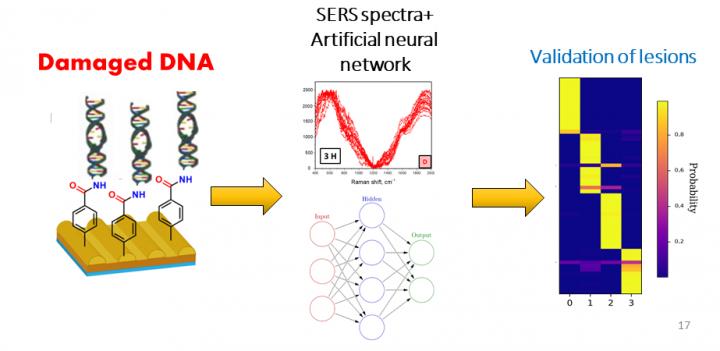

This is a schematic diagram of the SERS sensor operation in combination with the neural network for the analysis of DNA damage.
Credit: Tomsk Polytechnic University
According to the authors, the ways the UV could affect the DNA structure, especially with the short-term irradiation, remain practically unstudied. The UV radiation is also known to cause cancer. However, it is almost impossible to detect minor changes in the DNA structure.
“In the article Label-free surface-enhanced Raman spectroscopy with artificial neural network technique for recognition photoinduced DNA damage, we offer an alternative to well-known techniques. We used model samples such as oligonucleotides of various sequences. Some of them were irradiated with UV for different periods of time. Then, we used highly sensitive sensor systems developed by the research team based on plasmon-polariton gold gratings. The oligonucleotides were immobilized on the sensor surface. They subsequently were hybridized with the irradiated oligonucleotides. Then, the changes in the DNA structure were analyzed using a Raman spectrometer, ” Pavel Postnikov, Associate Prof. of the TPU Research School of Chemistry & Applied Biomedical Sciences, says.
He also noticed that the obtained spectra were used to train artificial neural networks. The analysis and interpretation of the oligonucleotide sequence spectra is quite a complex task, especially if it is large-scale and performed with a high level of statistics processing.
“Using neural networks enabled to avoid the numerical processing of a huge number of spectra and it freed us from the optimization of measurement procedure. Besides, the neural networks both reveal the damages and effectively predict changes in the DNA structure caused by UV radiation.
Moreover, the neural network in combination with the surface-enhanced Raman spectroscopy can detect changes with high accuracy, where traditional methods fail”, – Pavel Postnikov says.
The researchers believe that the neural networks and Raman spectroscopy can be successfully used for medical diagnostics in the future. Moreover, this technique can be further improved.
“Analysis of biological objects by Raman spectroscopy methods is still an extremely difficult, but interesting and promising issue. In this regard, DNA damages caused by the UV radiation was an extremely interesting model for us.
This concept provides the detecting of minor changes in the DNA structure. It can be expanded and improved, ” – Pavel Postnikov underlines. He also specifies, that the studies are supported by a grant under the TPU Competitiveness Improvement Program and conducted under the scientific supervision of Prof. Marina Trusova, the Research School of Chemistry & Applied Biomedical Sciences.
The Research School of Chemistry & Applied Biomedical Sciences implements more than ten various projects on the development of hybrid materials, combining different properties. One of these areas is the development of highly sensitive sensor systems.
Sensors are a multilayer construction: they are based on a thin, wavy gold film 1×0.5 cm in size, which is modified with diazonium salts, special organic compounds.
Due to the developments of the TPU research team, the sensor can detect toxic substances, heavy metals, and some diseases and defects in the DNA structure. The advantages of hybrid sensors are hypersensitivity, the speed of analysis and the ability to analyze at the sampling site.












